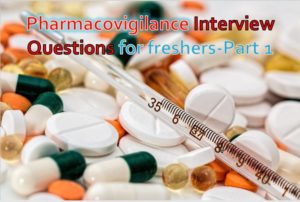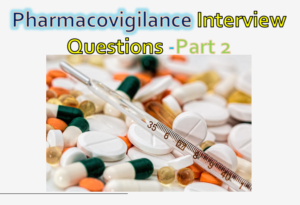Pharmacovigilance interview questions for freshers- Part 1
Pharmacovigilance interview questions given here in two parts. This post prepared from freshers point of view. Some of the questions may also be useful for experienced people. If you are looking for a job, you should aware of all these pharmacovigilance interview questions and answers. We have covered most of the questions usually asked in freshers interview for PV job . We hope that this pharmacovigilance interview questions will assist you face the interview successfully.
- Explain about Pharmacovigilance?
Ans) It collects adverse effects information of medicines, biological products and the data is analysed, monitored to prevent the adverse effects or other drug or therapy related problems. AE information is collected form healthcare providers(Doctors/Pharmacist/Nurse etc.) and patients etc.
What is the difference between adverse drug reaction or adverse drug event
Ans) Adverse drug event (ADE) is an untoward medical occurrence when a medicine is administered to a patient. It is an unexpected and unpredictable reaction, which does not necessarily have a casual relationship with drug action. But Adverse drug reaction is a noxious and unintended effect. It has a relationship with the drug action. ADR is a harmful effect occurs at a normal dose and normal use.
Related: Phases of clinical trials- Overveiw
- What are the objectives of Pharmacovigilance?
Ans) Objectives the pharmacovigilance is to enhance the patient and public care and safety by reducing the occurrence of adverse effects and its severity.
To encourage the rational and safe use of drugs by increasing the awareness and understanding of drugs.
Explain about types of pharmacovigilance?
Ans) There are two types of Pharmacovigilance available i.e Active and Passive Pharmacovigilance.
Active PV: It involves active measures to detect the Adverse event occurrence after or during the treatment. Patients are directly asked or patient screening records are checked to find out the any experienced adverse events.
Passive PV: It wont involve any active measures to detect the adverse events/effects. This is also called as Spontaneous or voluntary reporting. This reporting is mainly depending on initiative and motivation of reporters like Healthcare providers (Doctors, Nurse, Pharmacist etc) and Patients.
Related: List of pharma companies in hyderabad
Different phases involved a product development?
Ans) Screening of several thousands/Lakhs of compounds, few compounds enter into the Preclinical Testing followed by Clinical Trials. Then NDA filed for getting marketing approval. Formulation will be in the market once the product got the regulatory authority approval.
- Explain different phases in clinical trails ?
Ans) 3 phases involved in the Clinical Trials.
Phase I determines the drug safety and dosage by the help of pharmacokinetics of the drug. Except chronic disease (AIDS/Cancer) drugs, most of the remaining drugs tested in healthy volunteers.
Phase II: Once the drug safety confirmed, this phase starts to find out the effectiveness of the drug along with its side effects.
Phase III: This phase tested on a huge number (1000 to 3000) of patients. Before going to drug in the market, this phase confirm/ verifies the effectiveness of the drug in the trial.
Note: Phase 0 also belongs to the clinical trial phase known as micro dosing. Very small amount of the drug is administered in the human body to check whether the drug is behaving same as it is tested in the animals in the preclinical studies.
What are considerations for AE to be “serious” ?
Ans) Hospitalisation/Prolonged hospitalisation/ Disability/Life threatening/Death/Congenital anamoly.
Mention the drug regulatory authorities of India, USA, UK, Japan, Brazil, Australia, China, Thailand and Singapore?
Ans) India- CDSCO (Central Drugs Standard Control Organisation)
USA- USFDA (United Stated Food &Drug Administration)
UK- European Medicines Agency (EMA)
Japan- PMDA (Pharmaceuticals and Medical Devices Agency)
Brazil- ANVISA (National Health Surveillance Agency)
Australia – TGA (Therapeutic Goods Administration)
China – CFDA (China Food and Drug Administration)
Thailand – FDA (Food and Drug Administration)
Singapore – HSA (Health Science Authority)
- Explain about Volume 9A?
Ans) European Union prepared this Volume 9A. It provides guidance on pharmacovigilance roles, requirements, procedures and activities. These guidelines are for both MAH (Marketing Authorisation Holders) and Human use medicinal product competent authorities.
It contains 4 parts.
Part 1 discuss guidelines for MAH (Marketing Authorisation Holders)
2nd part is about guidelines for Medicinal product competent authorise.
Part 3 is about guidelines for electronic exchange of PV in European Union and
4th part deals with the guidelines on PV communication.
- What are the ICH guidelines related to Pharmacovigilance?
Ans) ICH E2A to E2F guidelines deals with pharmacovigilance.
E2A guidelines for Clinical Safety Data Management:
These guidelines deals with the terminology and standard definitions related to the clinical safety reporting. It also provides the guidelines on ADR rapid/expedited reporting mechanism during the investigational drug development phase.
E2B guidelines for Data elements transmission of ICSRs.
It provides guidelines on clinical safety data management and ICSR data elements transmission.
E2C –Periodic benefit risk evaluation report.
It provides guidelines on PSURs of marketed drugs which are having role in benefit risk evaluation.
E2D- It provides guidelines for Post approval safety data management.
E2E- It provides guidelines on Pharmacovigilance planning.
E2F- Development Safety Update Report: It provides guidance on DSUR. It is the data from the Investigational drugs in the clinical trials with or without having a market approval. Sponsors required to submit DSUR on every year.
Minimum data elements required for a valid case?
Ans) An identifiable reporter (Patient/Doctor/Pharmacist etc), An adverse event, An identifiable patient and an identifiable suspect product.
- Expand ICSR, DSUR, PSUR, PADER, SUSAR MedDRA, GVP, IBD, ESTRI, WHO ART and CIOMS?
Ans) ICSR – Individual Case Safety Report
DSUR- Development Safety Update Report
PSUR- Periodic Safety Update Report: European Medicines Evaluation Agency (EMEA) needs this PSURs.
PADER-Periodic Adverse Drug Experience Report: USFDA needs this PADERs.
SUSAR- Suspected Unexpected Serious Adverse Reaction
MedDRA- Medical Dictionary for Regulatory Affairs: MedDRA developed by ICH (International Conference on Harmonisation) and maintained by Maintenance Support Services Organisation (MSSO).
GVP- Good Pharmacovigilance Practices.
IBD- International Birth Date
ESTRI- Electronic Standards for the Transfer of Regulatory Information
WHO ART- World Health Organisation- Adverse Reaction Terminology: It is a dictionary for coding adverse reactions. WHO ART maintained by Uppsala Monitoring Centre (UMC), Sweden.
CIOMS-Council for International Organizations of Medical Sciences. For more information visit CIOMS website
- When the MedDRA is updated?
Ans) In every year of March and September, MedDRA updated. March updates presented in Metathesaurus release of November and September updates presented in May Metathesaurus release.
What do you know about Thalidomide disaster?
Ans) Thalidomides used as a mild sleeping agent and to treat morning sickness in pregnant women in 1960s. The major side effect of this drug is Phocomelia (severe Birth defects affecting the upper and/ lower limbs and foetal death. Thousands of babies affected by the malformed limbs.
What do you know about Tuskegee Syphilis Experiment?
Ans) It was an unethical study. Researcher(Doctors from Public Health Services) included the Tuskgee (a city in Macon country, Alabama, United states) sharecrappers without giving the proper information about the study. It was started in 1932 to know the disease progression of syphilis( a sexually transmitted disease). This study was continued upto 40 years. Study involves 399 latent syphilis patients and 201 normal healthy people as control- they were being infected with variety of ailments of bad blood. Syphilis patients are left untreated for knowing disease progression even though penicillin recommended treatment is available for syphilis from the year of 1947. Nearly most study participants are injected with syphilis infection. At the end of the study, most of study participants were died with syphilis or with its related complications and their wife’s and children infected with syphilis.
Pharmacovigilance interview questions part 2 is continuation to this post.
Related: Clincal sas interview questions for freshers
Please share this post to your friends and feel free to drop a comment below.

